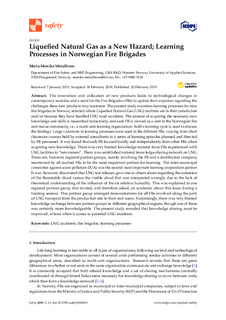| dc.description.abstract | The innovation and utilization of new products leads to technological changes in contemporary societies and a need for the Fire Brigades (FBs) to update their expertise regarding the challenges these new products may represent. The present study examines learning processes for nine fire brigades in Norway, selected where Liquefied Natural Gas (LNG) facilities are in their jurisdiction and/or because they have handled LNG road accidents. The process of acquiring the necessary new knowledge and skills is researched inductively, and each FB is viewed as a unit in the Norwegian fire and rescue community, i.e., a multi-unit learning organization. Kolb’s learning cycle is used to discuss the findings. Large variations in learning processes were used in the different FBs, varying from short classroom courses held by external consultants to a series of learning episodes planned and directed by FB personnel. It was found that each FB focused locally and independently from other FBs when acquiring new knowledge. There was very limited knowledge transfer from FBs experienced with LNG facilities to “newcomers”. There is no established national knowledge-sharing network on LNG. There are, however, regional partner groups, mainly involving the FB and a distribution company, mentioned by all studied FBs to be the most important partner for learning. The inter-municipal committee against acute pollution (IUA) was the second most important learning cooperation partner. It was, however, discovered that LNG test releases gave rise to observations regarding the extension of the flammable cloud versus the visible cloud that was interpreted wrongly due to the lack of theoretical understanding of the influence of the air relative humidity. This was explained to one regional partner group that invited, and therefore asked, an academic about this issue during a training session. This partner group arranged demonstrations for all FBs involved along the path of LNG transport from the production site to their end-users. Surprisingly, there was very limited knowledge exchange between partner groups in different geographical regions, though one of these was certainly more knowledgeable. The present study revealed that knowledge sharing must be improved, at least when it comes to potential LNG incidents. | nb_NO |

